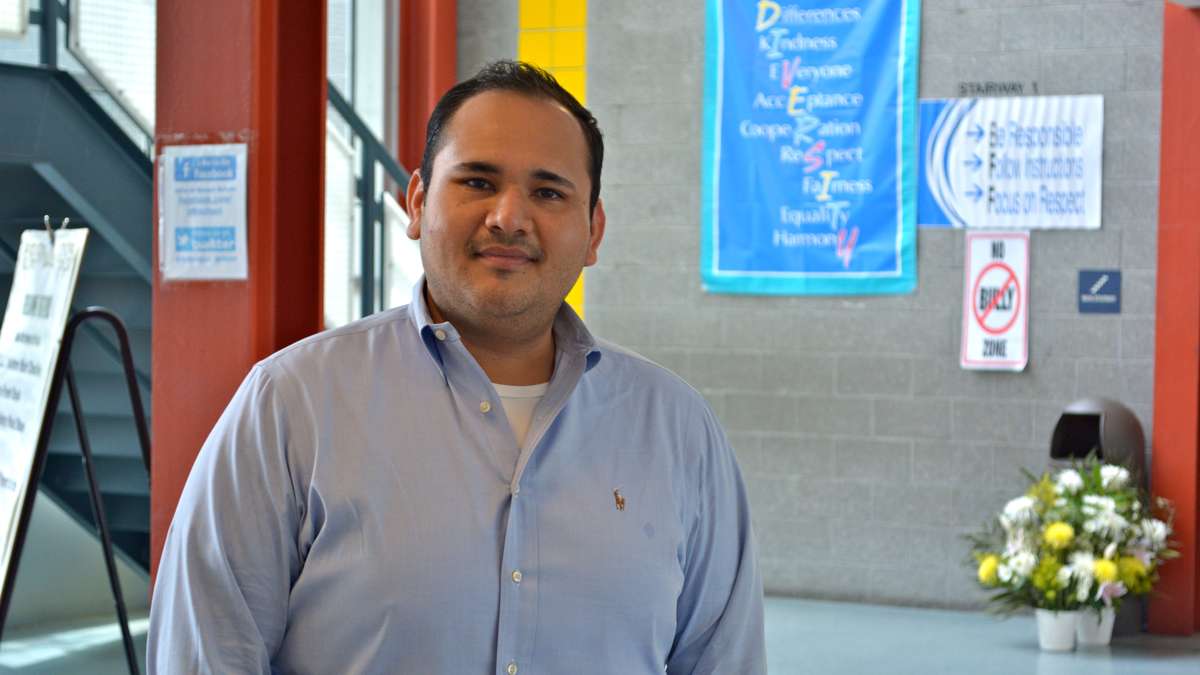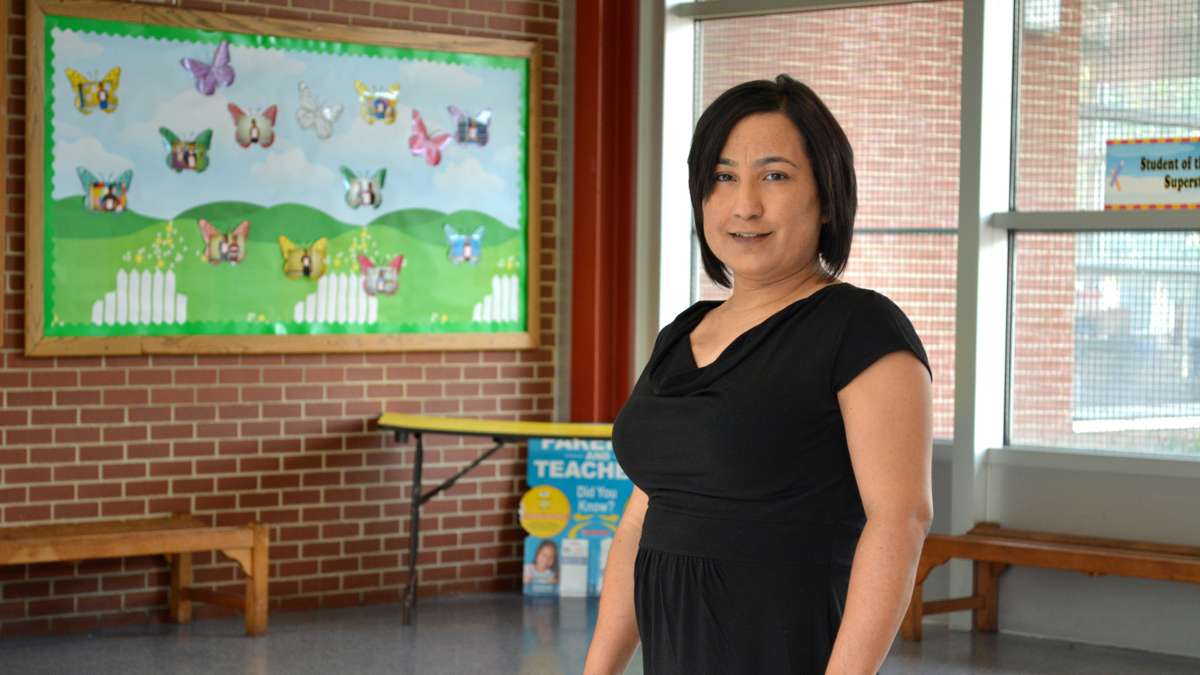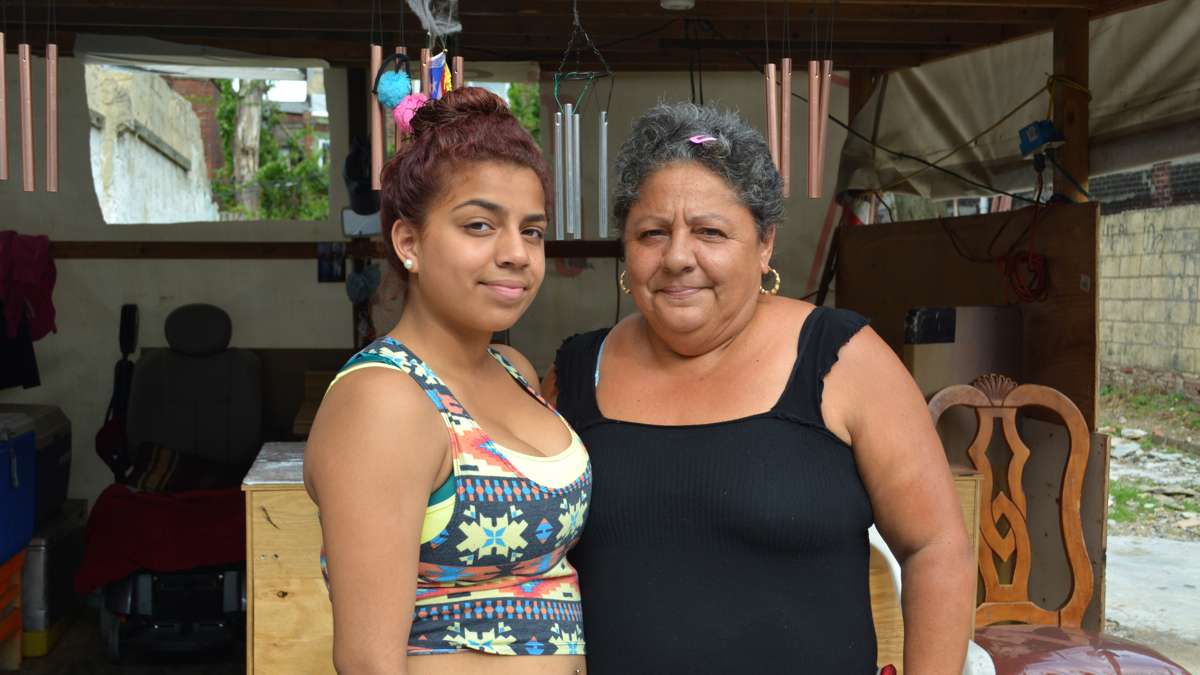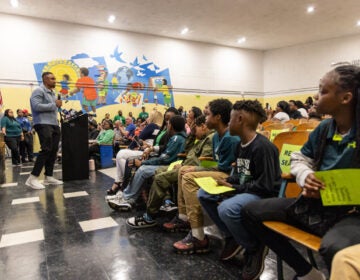How a Philly school in a free-fire zone went from lockdown to hopes up
ListenFor many Philadelphia students, profound violence and trauma underlie the rhythms of daily life – making academic success all the more difficult.
In one Philadelphia school this year, though, students and faculty took to the streets in one of the city’s most violent neighborhoods to demonstrate for peace.
They got results.
Fourteen-year-old Grisel Pellot knows too well the sound of gunfire.
Growing up on a narrow stretch of row homes in North Philadelphia’s Fairhill section, she’s learned to anticipate the worst.
“I do get that in my head — us walking and a shootout happens and one of us get hurt, or one of the little kids get hurt. I’ve been in those places before,” she said. “I had to save a baby.”
Grisel tells a story of seeing a gun battle breaking out on one end of the block, and then seeing a young girl babysitting an infant panicking on the other end.
The teenager risked her own safety to run back to grab the baby and return him safely to his house.
“So I took him to his mom, and she said, ‘Thank you.’ And I said, ‘Anytime.’ And then I went home,” said Grisel. “I didn’t come out for the rest of the day because I was scared.”
Learning to live with lockdowns
Dealing with danger on the streets was one thing.
Dealing with it during school hours was another.
But that became the case for Grisel and her classmates at Fairhill’s Julia de Burgos Elementary School early this school year, where classes were regularly interrupted for an unprecedented number of lockdowns after gunshots were heard nearby.
“Any time there’s a shooting and police are involved – so no one runs in, no one runs out – we have to lock the school down, and make sure that everyone who’s in, stays in,” explained Principal Maritza Hernandez, who grew up in the neighborhoods surrounding the school.
When a school goes on lockdown, students are shepherded away from windows. They hide under desks or take cover in corners. The ordeal can last anywhere from 10 minutes to more than an hour.
At de Burgos, a K-8 school where it’s common for drug deals to occur within sight of the school’s large glass windows, five lockdowns took place during the first six weeks of classes.
“We heard [the gun shots] came from drug sales or just rifts in the community with community members,” said Hernandez.
Schools like de Burgos must work to make children feel safe and secure before substantive learning can occur.
The difficulty of this task has been compounded in recent years by a tightening school district budget that has stripped schools of adequate levels of critical support staffers.
Lockdowns complicate the challenges on multiple fronts.
“We have an hour of missed instruction here. Ten minutes there. It kind of puts a damper on what we’re trying to do,” said Hernandez. “And then the kids become very anxious. Some of them, they were crying in the classroom.”
Even more harrowing for staff is when students seem unfazed.
“That’s also sad, for students to say, ‘Oh, that happens in my house all the time,'” said Hernandez. “That’s their reality.”
Grisel, an eighth-grader, says she tried her best to keep her cool through each lockdown, which often puts children in cramped, uncomfortable quarters.
“We don’t know if the guy was coming in here or anything, so we had to lock the school down and lock the doors and turn off the lights and hide so we won’t get killed,” she said.
Reaching a turning point
Assistant principal Julio Nunez says he was rattled most by the lockdown that occurred during de Burgos’ after-school program. Nunez was in the school’s main office, which has big glass windows overlooking the schoolyard, when he heard shots fired.
“All we hear is the ‘bang, bang, bang, bang,’ and I remember seeing the students playing basketball outside on the schoolyard, and they just started running,” he said.
Philadelphia police arrived shortly after, and none of the children was wounded. But Nunez can’t shake the memory.
“I think it reminded me of where the students come from when they reach our school and all those traumas that go undiagnosed,” he said.
Nunez says that’s a fact that can be too easily forgotten.
“We sometimes jump to conclusions that they are trying to get on our nerves, or trying to cause disruptions — which sometimes is not the case,” said Nunez. “Maybe that’s the only way they know of asking for help.”
Rising up to say ‘enough’
After the incident during the after-school program, Hernandez and Nunez decided that the school needed to rise up against the violence.
They organized a massive peace march with the help of the Congreso de Latinos Unidos nonprofit and other community partners. In mid-October, about 1,000 students, parents and teachers rallied through the neighborhood with the support of the police, the school district and business owners.
Hernandez and Nunez recently gave me a tour of the route, which included the row of shops on Fifth Street north of Lehigh.
“And all of these businesses were able to see a whole bunch of people just screaming these chants of, ‘No more violence, we want peace!'” said Nunez. “And some of them joined, right then and there.”
Nunez recently published an essay in the Public School Notebook urging readers to appreciate the people who persist in resisting the violence tearing through their communities.
After the march, months ticked by without a lockdown, but Principal Hernandez feared the guns would return.
“When the weather started to break and it became warmer, I thought to myself, ‘This will be the true test,'” she said.
At least during school hours, the streets remained silent for the rest of the year.
Faculty and students count this as a success story, one that reveals the untold strength of the good in the community.
“We kind of gave the students a voice,” Hernandez said. “And the students, that is one thing they actually remember about the entire year, ‘We had that peace march, and it was because of the lockdowns, and we no longer have lockdowns.’ Whether we’ll start next year with them, we’re hoping ‘no,’ but at least our students already know, give them a voice and they’ll be able to run with it.”
As Nunez points out in his essay, the community effort was aided in part by a large targeted police bust of Kensington’s open-air drug markets in April.
‘Everywhere is bad’
After the school year ended, I reconnected with Grisel Pellot outside of her house, where she lives with her mother and grandparents. Her father is in prison.
She and her grandmother, Aurora Sepulveda, both from Puerto Rico, sat in an open-air shack on an empty lot across from their house. The family passes hot summer days there – selling drinks to passers-by and listening to a Latino radio station.
For Grisel, who will attend high school in the fall, confidence in herself wars with anxiety about her city.
It’s a view reinforced by the territorial, block-by-block drug battles that surround her and the daily warnings she receives from her grandmother.
“She says we should hide because everywhere is bad,” said Grisel, translating for her grandmother.
In the last six months, in the square mile around Grisel’s house, police records show six homicides, 13 rapes and 84 robberies. Grisel recently attended the funeral for a 2-year-old boy killed in a hit and run.
Her grandmother warns Grisel to stay inside.
“I hardly come out,” said Grisel. “She’s just scared. She’s scared to lose one of her grandkids.”
Grisel worries as well — for the safety of her younger nieces and nephews.
She dreams that one day she’ll leave North Philadelphia and become an obstetrician – a profession where she can dedicate herself to the celebration of new life and earn enough money to raise her own potential children far from gunfire.
Until then, as Grisel sets her sights on medical school, the sound of death is never far off.
“People still dying. People dying for no reason,” she said. “Some people are innocent. Some people are not.”
WHYY is your source for fact-based, in-depth journalism and information. As a nonprofit organization, we rely on financial support from readers like you. Please give today.








